Now that the temperatures are skyrocketing and we're getting into summer-mode, I'm sure trips to the beach and hitting up a local pool is on the to-do list.
However, as you're packing up the swim diapers, towels, bathing suits and of course - sun block - can you be truly sure that you're slathering on the best sun protection?
Chances are, your sunblock of choice may be doing more harm than good.
However, as you're packing up the swim diapers, towels, bathing suits and of course - sun block - can you be truly sure that you're slathering on the best sun protection?
Chances are, your sunblock of choice may be doing more harm than good.
To get the real deal on the contents and safety of sunscreen (among thousands of other health and beauty products) the Environmental Working Group (EWG) has compiled this information for us.
EWG's mission is to use the power of public information to protect public health and the environment. If you visit their web site, you'll fall in love with them and refer to them frequently - mostly because of this:
EWG's mission is to use the power of public information to protect public health and the environment. If you visit their web site, you'll fall in love with them and refer to them frequently - mostly because of this:
At EWG, our team of scientists, engineers, policy experts, lawyers and computer programmers pores over government data, legal documents, scientific studies and our own laboratory tests to expose threats to your health and the environment, and to find solutions. Our research brings to light unsettling facts that you have a right to know.I love this statement and could not agree more. So back to the point of this post: sun block.
First, if you own any of the following items - get rid of them immediately:
(Note: Below is taken directly from EGW's site)
Hawaiian Tropic Baby Stick Sunscreen SPF 50
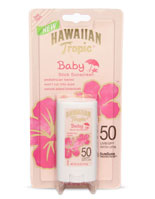 Hawaiian Tropic’s website claims “Less Chemical Sunscreens” for this baby sunscreen stick. Truth is, it contains two chemicals to that don’t belong on a baby’s skin – the hormone disruptor oxybenzone and a form vitamin A called retinyl palmitate. A recent federal government study shows retinyl palmitate may speed up the growth of skin tumors.
Hawaiian Tropic’s website claims “Less Chemical Sunscreens” for this baby sunscreen stick. Truth is, it contains two chemicals to that don’t belong on a baby’s skin – the hormone disruptor oxybenzone and a form vitamin A called retinyl palmitate. A recent federal government study shows retinyl palmitate may speed up the growth of skin tumors.The final straw? The UVA protection factor for this sunscreen is less than 10 – a far cry from the 50 SPF plastered on the package. It’s not good enough to be sold in Europe.
Baby Blanket SunBlankie Towelette SPF 45+
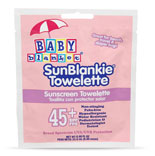
This baby sunscreen advertises “maximum allowable protection for babies” but doesn’t deliver. If the FDA’s proposed rating system were in force today, it would earn only one of four stars for UVA protection, according to EWG’s analysis. It doesn’t have enough UVA protection to meet European standards. Your baby’s skin may not get burned, but UVA rays could penetrate it and cause skin damage that would accumulate, possibly triggering cancer later in life.
Aveeno Baby Continuous Protection SPF 55
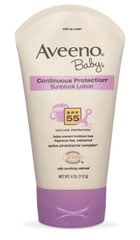
The label of this product says “mild as water.” We don’t think so. The label also warns, “Stop use and ask a doctor if rash or irritation develops and lasts.” And you wouldn’t want a child to swallow it like water. The label adds, “keep out of reach of children” and “get medical help or contact a Poison Control Center right away.” Sunscreen makers can make exaggerated claims because the industry is unregulated. FDA officials have been promising they may wind up their deliberations later this year – and then give the industry a year to adjust. If that’s the case, the rules may be ready for beach season – in 2013. In the meantime, EWG has created this guide to give consumers information they need to make the right decisions for themselves and their families.
Coppertone Water Babies Sunscreen Lotion SPF 70+
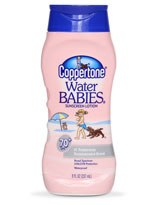 Coppertone advises users of this baby product to apply “liberally.” But scientists who have researched its key sunscreen chemical, oxybenzone, warn against using it over large surfaces of skin and over many hours. These warnings are particularly strong for young children who don’t eliminate toxic chemicals from their bodies as readily as adults and who have more skin relative to their body weight than adults. Oxybenzone readily seeps through the skin and into the bloodstream and acts like estrogen in the body. This Coppertone sunscreen is one of more than 20 sunscreens with the word “baby” in their name and the chemical oxybenzone on their ingredient lists. Don’t buy them.
Coppertone advises users of this baby product to apply “liberally.” But scientists who have researched its key sunscreen chemical, oxybenzone, warn against using it over large surfaces of skin and over many hours. These warnings are particularly strong for young children who don’t eliminate toxic chemicals from their bodies as readily as adults and who have more skin relative to their body weight than adults. Oxybenzone readily seeps through the skin and into the bloodstream and acts like estrogen in the body. This Coppertone sunscreen is one of more than 20 sunscreens with the word “baby” in their name and the chemical oxybenzone on their ingredient lists. Don’t buy them. Rite Aid Kids Sunscreen Spray Lotion SPF 45
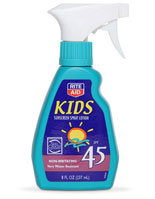
On the front of the bottle, this products claims to be “NON-IRRITATING.” Check the reverse panel, though and you’ll see a different message: “Stop use and ask a doctor if rash or irritation develops and lasts.” The Skin Cancer Foundation recommends this spray as “an effective UV sunscreen.” But it’s not good enough to be sold in Europe, according to a standard industry sunscreen model. Its UVA protection is too weak to earn a spot on store shelves in the European Union. If the FDA’s proposed UVA rating system takes effect as it is now written, Rite Aid Kids Sunscreen Spray Lotion SPF 45 would earn only one of four stars. Your children deserve better.
So, what would a better option be? Again, according to EWG, you want to look for the following in a sunscreen:
- Mineral sunscreens with ingredients like zinc and titanium
- NO oxybenzone (this is linked to hormone disruption)
- NO Vitamin A
- NO spray sunscreens or powders
Loving Naturals
California Baby
Badger
Aveeno
BabyGanics
Remember, babies under 6 months of age are not to be exposed to the sun for any length of time and should not have sunblock applied to them.
Thanks for reading!
Also, here's a shortcut to find more information on sunscreen brands:

No comments:
Post a Comment